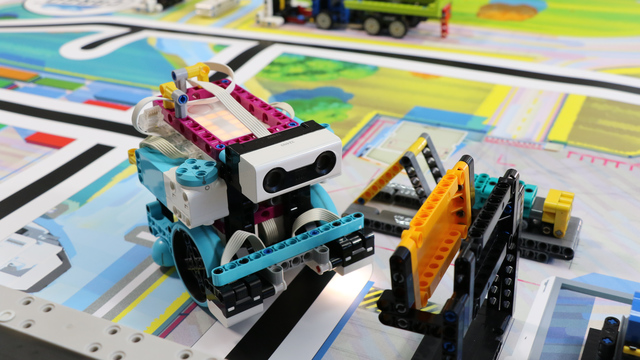
FLL 2023: Rules for Craft Creator M13 FIRST LEGO League 2023-2024 MASTERPIECE Challenge
Many technologies are used to enable all sorts of great creations to be made anywhere.
Release the creation from the craft machine.
- #2203
- 25 Aug 2023

Many technologies are used to enable all sorts of great creations to be made anywhere.
Release the creation from the craft machine.

Augmented reality transforms a piece of art into an experience.
Rotate the statue to reveal an augmented reality experience.

What makes something art? Create an amazing art piece worthy of being displayed in a museum.
You can use the bricks in Bag 4 to build your team’s LEGO® art piece. Bring it to the match and then deliver it on the pedestal to the museum.

Immersing viewers so they are surrounded by the art allows them to experience and appreciate it in new ways.
Trigger the immersive experience for the viewer in the model.

Mechanical technology can support a theater performance by seamlessly changing the scenery, keeping the audience focused on the story.
Change the scenery to a different configuration, and consider what the other team will do so that you end with matching scenes.


This is a 10 out of 10 video tutorial where we demonstrate the consistency and reliability of a LEGO Education SPIKE Prime Active attachment connected to the motors of the robot. The goal of this attachment is to accomplish the Bridge mission where we have to push both parts of the bridge and bring them down to connect them. We use some line following.


In this video tutorial, we accomplish a FIRST LEGO League mission called The Bridge. We demonstrate how to use a really simple active attachment where the goal of the mission is to push down both parts of the bridge. We do not enter into the programming and we leave it up to you as an exercise.


In this 10 out of 10 tutorial, we accomplish the Platooning Trucks from FIRST LEGO League (FLL) 2021-2022. The goal of the mission is to connect the trucks to each other and both of them to the bridge. The attachment and the robot pushes the trucks and we do it 10 times to see the consistency and reliability of the robot.


In this video tutorial, we accomplish the FIRST LEGO League 2021-2022 mission called Platooning Trucks. The goal is to connect the two mission models (trucks) to each other and then connect them both to the bridge. It's quite an interesting mission as it involves three mission models.

This is a recording of a completely perfect, 10 out of 10 accomplishment of a two-part mission - Train tracks, from the FIRST LEGO League 2021-2022 Cargo Connect competition. Due to the proper use of motion and color/light sensors, the robot is 100% consistent and reliable for a non-trivial mission. Even when the robot makes a mistake, it auto-corrects and compensates for this mistake.


This tutorial explains the use of motion and light/color sensors to accomplish a complex mission split into three parts. It gets into detail about how we keep a straight line with the motion sensor, follow a line with the color sensors, and transition between different parts of the program by aligning and detecting lines with the sensor. The goal is to get to a reliable and consistent behavior of the robot. On top of that, it is configurable, as we've left a few parameters that could be set to configure the behavior for a specific robot, venue, lighting, battery level, and wheels friction.


"Sometimes it works, sometimes it does not work" - this is the most common case in FIRST LEGO League competitions. In this tutorial, we demonstrate and discuss such a case where the first part of accomplishing the mission always works but the second part has about 60-70% success rate. The robot is not very consistent. Let's take a moment to see it and explain why so that we can resolve the problem in the next lesson.


In this video tutorial, we use the motion sensor and demonstrate 10 out of 10 times how we can keep the robot moving in a straight line. The program is described in the previous tutorial in the lesson where we enter into the programming. Here we visualize how consistent and reliable the behavior of the robot is.


In this video tutorial, we use the Unload Cargo Ship mission from FIRST LEGO League 2021 Cargo Connect robotics competition to demonstrate how we program the robot to keep a straight line while moving. Do we need that for this mission? Probably not, but we do it either way to demonstrate the solution in a fairly simple mission. The program uses the motion sensor to auto-correct the errors the robot is making while moving.


What if the robot could make a mistake and still accomplish the mission? That is what we demonstrate with this tutorial - a few principles for error tolerance and self-correction. Even though we start the robot from a few different places, we manage to complete the mission with the same program every time. We use the LEGO Education SPIKE Prime robot, and we continue directly after the 10 out of 10 tutorial


This is a 10 out of 10 tutorial for pushing gently on a mission model. We also discuss how to build robots that tolerate error and auto-correct their behavior.


In this video tutorial, we demonstrate how to gently push an object to accomplish the mission. "Gently" means that we are pushing but not with force. If we push using force, the mission model will fall, and we will not accomplish the mission. We use LEGO Education SPIKE Prime and the Ultrasonic Sensor.


This video tutorial demonstrates the consistency and reliability of the active attachment that pushes the two mission models. The goal is to use both the attachment and the robot to push the mission model and move the truck and the plane after the blue lines.


In this video tutorial, we push two of the mission models with a pinless active attachment with gears. The goal is to push the mission models after the blue lines. This attachment is interesting as it demonstrates a non-straightforward idea of how we can push the mission models. We explain the Scratch program and how we use the motion sensors - you will learn how to turn to a specific angle by using the motion sensor.


This is a 10 out of 10 tutorial that demonstrates the consistency and reliability of the robot to complete the Unused capacity mission. In this mission, we do not need any guidance to push the model as it is near the west side where it should arrive.


In this video tutorial we accomplish the Unused Capacity mission by pushing the mission model outside of the field in the area where we are allowed to touch the robot. We deliver the mission model to the side of the field. Before delivering, we must of course reach it and that's not always easy.


This is a 10 out of 10 tutorial demonstrating the consistency and reliability of a LEGO Education SPIKE Prime robot when the robot delivers a mission model to a specific position on the field.


In this video tutorial we deliver the Innovation project model from base to the cargo connect marker on the field. The goal of the mission is to deliver. The mission model is assembled before that.

Factories use large amounts of energy to make the products we use such as toys.
Deliver energy units to the toy factory bin and release the mini dinosaur toy.

Demand for energy is very high, and many different energy sources can be used to meet that demand.
Release the three energy units from the power plant.

Energy consumption in our homes is part of everyday life, such as watching the television.
Raise the television screen and move the energy unit to the television slot.

Renewable energy from the wind is used to turn the turbine blades and generate electricity.
Release the energy units from the wind turbine.